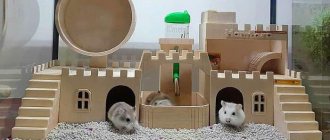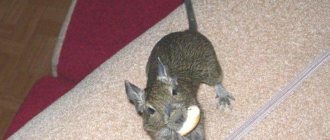Toilet
You can buy a toilet for your hamster at the pet store. The kit includes special granules that serve as bedding. They perfectly absorb all moisture, and therefore odor. Change once a week. Allows you to ensure cleanliness and freshness in the cage and room. In addition, they help clean the cage. It’s easier to just replace the litter in the toilet than to search throughout the cage where he did his job. But there is a nuance here: it is unlikely that an adult will be toilet trained, so this must be done as early as possible.
What types of hamsters are there?
Rodents vary in color, size and coat type. There are five types of domestic hamsters in total. Their standards, The National Hamster Council, are set by the National Association of Hamster Fanciers of England.
Syrian hamster
This is the largest Syrian Hamsters from home. The average length of its body is 13 cm. Females are sometimes larger than males.
The classic color of the Syrian hamster is golden brown. There is black ticking on the back - this means that areas of different colors alternate on the hairs. The animal's belly is white with gray undercoat, and there are dark spots on its cheeks.
Individuals of other colors are often found: white, cream, brown, black, gold, silver-gray, striped.
Hamsters of this species can have different coats. There are four types in total:
- Short . The soft fur fits snugly to the body.
- Long . The length of the hairs is from 7.5 to 10 cm.
- Rex . The fur appears tousled.
- Satin . The hair has a glossy shine. It is not recommended to crossbreed two hamsters with such hair, because sometimes the offspring will be bald.
Syrian hamster with classic color. Photo: Olena Kurashova / Shutterstock
Campbell's Russian Hamster
The body length of such a rodent, Dwarf Exhibition Standards, is 10–12 cm. There are three main colors of the animal:
- Normal . The hairs on the back are brown. The belly is white with gray undercoat. The eyes are black.
- Argenta . The top layer of wool is orange-sand, the bottom is smoky-gray. The eyes are red.
- Albino . These are completely white pets with bright pink eyes.
Hamsters with gray, beige, black and chocolate fur are considered non-standard.
Campbell's Russian hamster with normal color. Photo: softkrafts.live.com/Depositphotos
Djungarian hamster
This Dwarf Exhibition Standards animal is sometimes called the Russian white dwarf hamster. Its body length is 8–10 cm. All pets of this species have a black stripe on their backs. There are only three colors:
- Normal . The body is dark brown, with black ticking on a third of the hairs. The paws and belly are white, and the ears are gray.
- Pearl . The rodent's fur is white.
- Sapphire . The fur on the back is smoky gray with a blue tint, the belly is white.
Sapphire colored Djungarian hamster. Photo: Faifarris4746/Shutterstock
Chinese hamster
This rodent looks like a mouse without a long tail. Its body length is 10–12 cm, weight is 45–50 g. There are two main colors of the Chinese Hamster animal:
- Normal . The back and sides are brown with a chestnut tint, the belly is white. A black stripe stretches from the forehead to the tail.
- Spotted . Most of the fur is white. There is an elongated brown spot along the spine.
Albinos with black eyes are extremely rare. They come in litters from spotted parents. But this is the exception rather than the rule.
Chinese hamster with normal color. Photo: alexvey/Shutterstock
Roborovsky's hamster
The smallest of domestic rodents. It weighs only 20–25 g, and its body length is 4.5–5 cm. Typically, these animals have golden-brown fur on their face and back. The roots of the hairs are gray, and there are light spots near the eyebrows. But very rarely there are hamsters with a white muzzle.
Roborovsky's hamster. Photo: Anyarnia/Shutterstock
House
What a hamster needs in a cage for sure is a house. As a rule, it is attached to the bars of the cage somewhere in the corner. The dimensions must be sufficient to accommodate all the supplies of the rodent and himself. The fact is that in the course of his life, he will drag all his food there, making a kind of warehouse. The inside should be darker than other areas of the cage, since it also serves as a shelter where the pet will experience unfavorable times. For example, after moving, he will be stressed and the pet will look for somewhere to hide, and in a dark place he will feel safe. Another use for it is for sleeping, but often the hamster does not sleep in the house and looks for another place for this. Don't worry about what you put in your hamster's house, he will find everything himself. But if you want to do everything in your power, buy a special filler for the house.
What do you need to keep hamsters?
Rodents are often owned by people who have little free time. Miniature pets are unpretentious and require less attention than dogs and cats. However, this does not mean that caring for them can be done carelessly. No matter how tiny a pet is, it has its own characteristics, and you will need to create optimal conditions for its maintenance.
It is recommended to equip a home for a hamster in advance, even before the baby arrives at its new home. How to do it?
What a hamster needs: list
1. Cage
A cage is a whole world for your pet, and it is advisable that it be more spacious! Minimum recommended dimensions: 30x50x30 cm. The more hamsters you have, the larger the cage should be. Choose models with a continuous removable tray. This will make cleaning easier and save sensitive paws from damage (unlike the mesh bottom).
The size of the cage depends on the type of pet, its size and lifestyle: whether it prefers to live in company or alone. Before you buy a crate, make sure it will fit him.
2. Drinker and feeder
The hamster will need a special feeder and drinker. These are two different containers. In pet stores you will find many different models that are attached to cage bars or mounted on a pallet. All hamsters have their own preferences and habits. Some enjoy drinking from hanging drinkers, while others prefer floor-mounted ones. Very soon you will determine which category your pet belongs to and will be able to indulge his cute habits.
3. Feed
Good health is impossible without proper feeding. You can feed your hamster natural foods, but in this case you will have to study a lot of information and learn how to carefully balance the components of the diet.
The simplest and most useful solution is ready-made balanced food specifically for hamsters. Check out Fiory's classic vacuum-packed complete lines. From time to time, do not forget to pamper your pet, for example, with special fruit or nut sticks (Fiory Sticks). Treats should be healthy too!
4. House
You need to install a house for the hamster in the cage. In it the animal will sleep, relax and simply hide from the surrounding bustle. It is very important that no one disturbs the hamster in the house: this is his secluded, cozy hole.
You can buy a special house at a pet store. The choice is very large, and you can choose a model to suit every taste.
5. Litter (filler)
The cage tray must be “insulated” with bedding. It will absorb liquids, retain odors, help maintain cleanliness and, most importantly, prevent the hamster from freezing. Special sawdust or corn fillers (for example, Fiory Maislitter) are used as bedding for rodents.
6. Mineral stone
Hamsters' front incisors grow throughout their lives. To ensure that they are worn down in a timely manner and do not turn into a problem (malocclusion), a special mineral stone (also called a bio-stone) must be installed in the cage. In addition to oral care, it will also provide a source of beneficial minerals for your hamster.
7. Toys
Hamsters are incredibly cheerful and very playful pets. They will need a variety of toys to have fun. The main thing is to choose safe models designed specifically for rodents and suitable for your pet in size. Other items are potentially dangerous for him! For example, wooden toys leave splinters, and an improperly sized running wheel can lead to spinal injuries. Be careful!
8. Carrying
Even a completely healthy hamster should be periodically taken for a preventive examination to a specialist. Or perhaps you are planning to take part in exhibitions with your pet? For such cases, it is better to have a carrier in the house. You can purchase it at a specialized pet store.
This is what the first shopping list for your pet looks like. Over time, you will get to know your ward better and acquire other useful and interesting things for him.
Cozy houses for your little pets!
Running wheel
The list of things a hamster needs in a cage must include a running wheel. It will allow the fluffy to always stay in shape. In the wild, they run many kilometers every day; this need must be satisfied at home. Otherwise, the animal will be lethargic and weak, it will have nowhere to put its energy, of which it has plenty. The wheel must meet certain standards. The dimensions must be correct, otherwise the hamster will not run in the wheel. For dzungaria, a diameter of 12 centimeters is suitable. Syrians need 18+. The running surface should not be slippery or contain holes where the foot could fall through. To keep your hamster cage healthy and active, your hamster cage accessories must include a running wheel.
Fun outside the cage
The hamster's natural instincts are manifested in its behavior. Owners who want to diversify their rodent's stay in the house can pay attention to carriers. They are performed in the form:
- a walking ball - the animal will happily run around the apartment in such a device;
- plastic container - suitable for transporting a pet to a veterinary center, or for simple walks.
Attention! It is forbidden to carry a hamster in a pocket or bag. Indiscretion will result in loss, injury, and death of the baby.
Useful tips and advice for beginners
Proper maintenance of a hamster comes down to following these recommendations:
- The hamster should be kept alone in a separate enclosure.
- The pet should be isolated from noise and stressful situations.
- The air in the room where the pet lives should not be allowed to become hypothermic.
- You cannot take the animal outside and let it run around on the grass.
- You cannot use food from the table to feed your pet. Fatty, sweet, spicy and sour foods have a detrimental effect on a weak digestive system.
List of required items
The hamster is an unpretentious animal, but this does not mean that it is not worth purchasing anything for a comfortable stay. There are a number of things that are vital. In their absence, it will be extremely difficult to make a nimble friend; his health depends on special things for the hamster. The following purchases are required:
- Cell;
- Feeder;
- Drinking bowl;
- House;
- Wheel.
To diversify everyday life, there are a number of things that brighten up your leisure time.
- Walking ball;
- Ladder;
- Pipes;
- Swing;
- Decorative feeder.
Buy a special balanced food for hamsters, filler, which includes sawdust, vitamins, and mineral stones.
Used cells
There are situations when the owners only have a used cage at their disposal. It could be given away by friends or acquaintances in good condition. Or you are simply forced to buy one due to financial problems. There is nothing wrong with using space that previously belonged to another owner. You just need to thoroughly disinfect it. Hamsters are sensitive to smell, and the aroma of the former inhabitant will not be pleasant to the new owner.
To eliminate odor, use wine vinegar diluted in water. For cleaning and washing, you can use detergents or disinfectant wipes. Cleaning with chlorine-containing substances is not recommended, as it is difficult to wash off the remaining chlorine afterwards. To be on the safe side, you can additionally treat the surfaces with a special disinfectant without a strong odor, and then wash them in a hot soapy solution. After this, pour boiling water over everything and dry. It needs to be dried thoroughly in the open air. Having completed the entire processing process, you can then arrange the cage and choose a convenient place in the house where the hamster’s home will be located.
Rules for choosing housing for a hamster
For a hamster to appear in the house, you need to choose housing for it. The main rule when choosing a cage is that it should consist of metal. It is better if the grilles are not covered with paint. One of hamsters' favorite pastimes is gnawing; he can simply eat up dyes. It is contraindicated to put them in wooden, and even more so cardboard, dwellings; the hamster can easily gnaw through them. It is also necessary to take into account the size of the home, because we need to fill the house with things. Check the integrity of the door latch. The bottom comes in two types: removable and solid. This is a choice at your discretion. The gaps between the rods must be small, otherwise the animal will crawl between them. Cages can also be one-story or two-story.
How to choose a cage for a hamster
hamster's cage The size should be chosen taking into account the breed of the pet. The Dzungarians can be kept in a small one, but the Syrians will need a larger home. The material matters too. Cages with wooden parts are not suitable for rodents in principle. The grille should be metal - only stainless steel, since zinc and copper can cause serious health problems if they enter the pet's body. It is best to purchase a cage with a food-grade plastic tray and a stainless steel grid coated with animal-safe paint. Plastic is a durable and neutral material; even if a hamster chews on the tray, it will not harm its health. Primary polypropylene does not contain chemical additives that are dangerous for pets. Stainless steel will withstand the teeth of even the most active hamster - it will not be able to gnaw through a rod, but it can easily sharpen its teeth. And at the same time, chew off the paint. Therefore, the dye must be on a neutral basis; powder paint applied under pressure has proven itself best. Other dyes may contain chemicals that are harmful to pets. They usually have a pungent odor, so pay attention to this point when purchasing. The cage door is located on the side or top. Immediately after purchase, you need to check how securely it closes so that the hamster cannot open it himself. At first, you need to keep an eye on your pet - among hamsters there are lovers of walks who manage to crawl through even a small gap between the door and the cage, and this can become a serious problem for the owners.
Diseases: treatment and prevention
With balanced feeding and proper care, hamsters rarely get sick.
But they are not immune from some diseases:
- Cystitis. It is an infectious disease that affects the urinary tract. Symptoms include voluntary urination with blood. To treat and prevent cystitis, your pet is given injections of chloramphenicol. The dosage of the drug is selected at the rate of 5 mg per 100 g of weight 2 times a day.
- Enteritis. It occurs due to the progression of the infection and in 20% of cases leads to the death of the animal. You need to fight the disease with 2 antibiotics: neomycin and tetracycline.
- Scabies. Appears against the background of the activity of scabies mites, which produce oviposition in the upper layers of the skin of hamsters. The pest eats skin dandruff, causing severe discomfort to the animal. Scabies is fought with a 3% SK-9 solution and sulfur ointment. As a preventative measure, use chlorophos at a concentration of 1%. Repeated treatment is performed after 7 days.
Stress management
All rodents are exposed to stressful conditions, so you need to know how to avoid them. Often discomfort is provoked by the pet owner, who often checks the growth of the offspring, causing the female to get angry.
Depression in a hamster also appears when new individuals are added to it. It is better to refuse such a neighborhood, because... animals are able to grow together only from an early age. Adult animals must live in separate cages.
You should not allow a sudden change in your usual daily routine. In addition, lack of food or dirty bedding can trigger stress. Therefore, you should not neglect basic care of the enclosure.
It is forbidden to take the hamster outside, because... this irritates him greatly. Isolate the cage from dogs, cats and small children.
Leave the hamster in peace and quiet for several days after purchase.
How to set up a hamster cage
The hamster is a charming and unpretentious pet, the maintenance of which does not require much effort from the owner. A variety of colors and breeds allows you to purchase a fluffy dog to suit your taste: Djungarian, Chinese, Syrian. Hamsters are ideal pets for people who spend a lot of time outside the home, as well as for children and teenagers. A child, caring for a little friend, will learn to be responsible, attentive, and caring. However, in order for an animal to be healthy, cheerful, active and make you happy, it needs to be provided with optimal conditions for a happy and long life. What is meant? First of all, a spacious and comfortable cage that will have everything you need. The requirements for “housing” for hamsters are quite modest; you can easily find everything you need in a pet store. You will need:
- house;
- Bowl;
- drinking bowl;
- mineral;
- toys for active recreation.
A happy, healthy hamster will be happy to sit on your palm, take treats from your hand, communicate with its owner and give a lot of positive emotions. Do you want to know how to choose and equip a cage correctly so that your pet likes it and fits into the interior?
Pros and cons of content
We have already repeatedly noted that having a pet in the house is always a responsibility, and before purchasing one, you should weigh all the pros and cons. We tried to describe the main advantages and disadvantages of keeping a hamster in an apartment. We hope they will help you decide whether to have one in your home or not.
Advantages:
- goodwill - rodents, when treated and maintained correctly, rarely cause problems to the health and property of the owner;
- unpretentiousness - small portions of food and no need for street walks are, of course, a significant advantage of hamsters over other pets;
- ease of training and taming;
- the cage takes up little space;
- undemanding food;
- inexpensive price.
Flaws:
- disorder in the cage;
- unpleasant odor without regular cleaning;
- nocturnal lifestyle and, accordingly, the noise that is made;
- short life expectancy;
- rare manifestations of aggression.
What to feed hamsters
Like many pets, hamsters are fed twice a day. Your hamster's diet may vary depending on the season, but a grain mixture must be present in the daily menu. There are now ready-made grain mixtures on sale that contain millet, wheat, and oats in the required proportions.
Vegetables and fruits should be offered to hamsters in moderation. These can be carrots, beets, apples and pears. You can pamper your hamster with fresh herbs or nuts.
From time to time, it is necessary to include vitamin and mineral complexes in your hamster's diet.
Ensuring activity
It is forbidden to keep a hamster in a miniature enclosure or a 3-liter jar. This will lead to a deterioration in his health and the development of various diseases.
Proper care involves organizing leisure time. Therefore, pet owners set up entire play complexes, labyrinths and tunnels where the animals spend all their free time.
Walking around the apartment is allowed only in a special ball. If this rule is not taken into account, the hamster may be in mortal danger: falling into a boiling pan, eating a plant containing toxic substances, chewing through an electrical wire, etc. It is quite difficult to catch him in the apartment.
It is forbidden to arrange walks on high surfaces, because there is a risk that the pet will fall.
Is it possible to walk outside
Some owners allow their hamster to roam outside. But pets experience extreme stress from such a change in environment. In addition, such a walk can provoke fatal diseases.
In nature, the hamster is under threat of attack by predators. In addition, the nimble animal can quickly hide in any hole, and after that you will not be able to find it. On the surface of grass and soil there are often dangerous parasites that carry infections.











